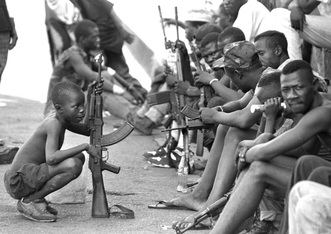History of Sierra Leone's Civil War

Many African countries such as Angola, Democratic Republic of the Congo, Republic of the Congo, and Liberia have suffered from devastating civil wars induced by rebel groups’ desire to control diamond mines. Most notably, Sierra Leone broke out into a bloody civil war from 1991 to 2002 that left hundreds of thousands of people displaced, raped, mutilated, or killed.[1] Over one third of the population was forced to flee their homes during the terror of the Revolutionary United Front (RUF).
The violent actions committed by the RUF were made possible by the illegal trade of blood diamonds, also known as conflict diamonds, which accounts for approximately 4% of the world’s diamond production.[2] The RUF took over control of Sierra Leone's diamond mines and the money generated by blood diamonds paid for weapons that fueled the war. In 2000, the United Nations (UN) banned the import of diamonds from Sierra Leone to the member states of the UN, which helped to stabilize the country and led to an increase in legal exports of Sierra Leonean diamonds.[3]
Following the brutal 10-year war, Sierra Leone today is a participant of the Kimberley Process and exports approximately 3% of the world’s diamond market. To this day, diamonds are one of the major resources in the development of Sierra Leone. Revenues from diamond exports are making a positive contribution to rebuilding the country’s infrastructure, health services, and education systems.[4]
However, despite the positive developments in Sierra Leone, victims of the civil war still need assistance. The children of amputees are particularly affected as their parents have lost their livelihoods as farmers or vendors; thus, lack the means necessary to provide financial support for their children’s education. Sierra Leone's literacy rate is only at 48% and the life expectancy at birth is less than 60 years.[5]
Sierra Leone most recently was affected by the 2014 Ebola outbreak, one of the worst widespread outbreaks of the virus in history. There were over 14,000 confirmed cases and nearly 4,000 lives lost in Sierra Leone.[6] The country’s infrastructure was overwhelmed by the crisis. Medical and burial teams were getting exhausted as they worked around the clock, helping those infected and burying the deceased. Over a billion dollars in aid were sent to combat Ebola by charities, NGOs, and foreign governments.[7]
The country was declared Ebola free in March 2016 but it is still reeling from the effects of its aftermath. Many children were left orphaned, leaving them unable to further their education with one or both parents and other family members gone. There are over 12,000 orphans due to outbreak. Some children are being rejected by their friends because of the stigma of Ebola and have tried to take their own lives, while girls are being forced into commercial sex work to provide income their parents would have previously provided.[8] Sierra Leone continues to recover from the scars of a tragic civil war and Ebola outbreak.
[1] https://www.cia.gov/library/publications/the-world-factbook/geos/sl.html
[2] African Development Bank, OECD Organisation for Economic Co-operation and Development (2009)
[3] http://news.bbc.co.uk/2/hi/africa/821166.stm
[4] http://www.diamondfacts.org/index.php?option=com_content&view=article&id=132&Itemid=169&lang=en
[5] https://www.cia.gov/library/publications/the-world-factbook/geos/sl.html
[6] http://apps.who.int/ebola/current-situation/ebola-situation-report-16-march-2016
[7] http://www.worldbank.org/en/topic/health/brief/world-bank-group-ebola-fact-sheet
[8] https://www.theguardian.com/global-development/2015/mar/04/ebola-leaves-12000-orphans-sierra-leone
The violent actions committed by the RUF were made possible by the illegal trade of blood diamonds, also known as conflict diamonds, which accounts for approximately 4% of the world’s diamond production.[2] The RUF took over control of Sierra Leone's diamond mines and the money generated by blood diamonds paid for weapons that fueled the war. In 2000, the United Nations (UN) banned the import of diamonds from Sierra Leone to the member states of the UN, which helped to stabilize the country and led to an increase in legal exports of Sierra Leonean diamonds.[3]
Following the brutal 10-year war, Sierra Leone today is a participant of the Kimberley Process and exports approximately 3% of the world’s diamond market. To this day, diamonds are one of the major resources in the development of Sierra Leone. Revenues from diamond exports are making a positive contribution to rebuilding the country’s infrastructure, health services, and education systems.[4]
However, despite the positive developments in Sierra Leone, victims of the civil war still need assistance. The children of amputees are particularly affected as their parents have lost their livelihoods as farmers or vendors; thus, lack the means necessary to provide financial support for their children’s education. Sierra Leone's literacy rate is only at 48% and the life expectancy at birth is less than 60 years.[5]
Sierra Leone most recently was affected by the 2014 Ebola outbreak, one of the worst widespread outbreaks of the virus in history. There were over 14,000 confirmed cases and nearly 4,000 lives lost in Sierra Leone.[6] The country’s infrastructure was overwhelmed by the crisis. Medical and burial teams were getting exhausted as they worked around the clock, helping those infected and burying the deceased. Over a billion dollars in aid were sent to combat Ebola by charities, NGOs, and foreign governments.[7]
The country was declared Ebola free in March 2016 but it is still reeling from the effects of its aftermath. Many children were left orphaned, leaving them unable to further their education with one or both parents and other family members gone. There are over 12,000 orphans due to outbreak. Some children are being rejected by their friends because of the stigma of Ebola and have tried to take their own lives, while girls are being forced into commercial sex work to provide income their parents would have previously provided.[8] Sierra Leone continues to recover from the scars of a tragic civil war and Ebola outbreak.
[1] https://www.cia.gov/library/publications/the-world-factbook/geos/sl.html
[2] African Development Bank, OECD Organisation for Economic Co-operation and Development (2009)
[3] http://news.bbc.co.uk/2/hi/africa/821166.stm
[4] http://www.diamondfacts.org/index.php?option=com_content&view=article&id=132&Itemid=169&lang=en
[5] https://www.cia.gov/library/publications/the-world-factbook/geos/sl.html
[6] http://apps.who.int/ebola/current-situation/ebola-situation-report-16-march-2016
[7] http://www.worldbank.org/en/topic/health/brief/world-bank-group-ebola-fact-sheet
[8] https://www.theguardian.com/global-development/2015/mar/04/ebola-leaves-12000-orphans-sierra-leone
